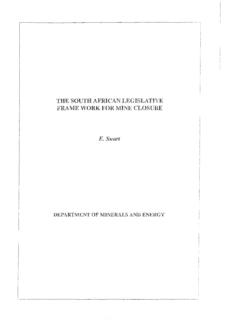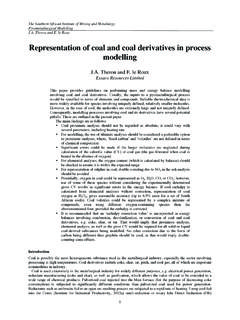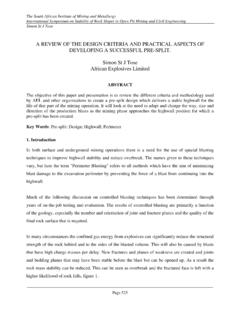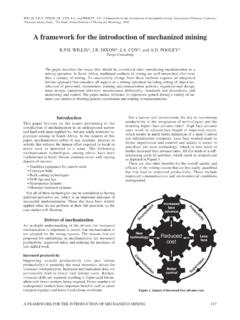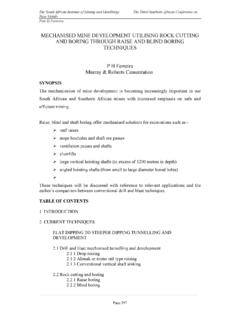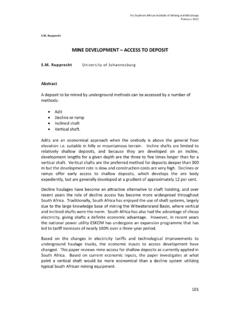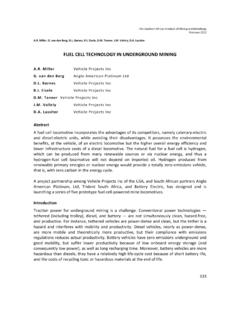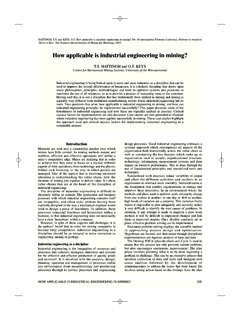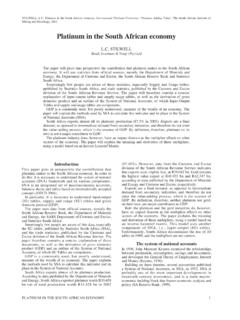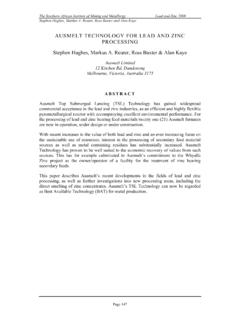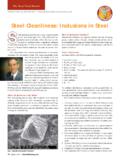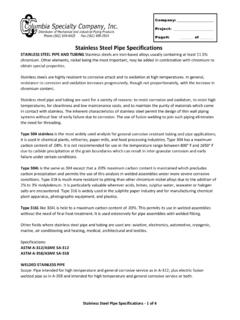Transcription of DEKKERS, R., BLANPAIN, B., PLESSERS, J., and …
1 steel cleanliness AND hydrogen IN liquid STEEL753 IntroductionWith increasing demands on steel quality, control ofparameters affecting the steel cleanliness becomes moreimportant. steel cleanliness may refer to the number ofimpurity elements or the number of inclusions present inthe steel . The number, morphology and type of non-metallicinclusions determine the steel cleanliness . In industry, thetotal amount of oxygen in steel is frequently used toindicate the degree of steel cleanliness . Since the amount ofdissolved oxygen is about constant, the total oxygen contentis a measure of the number of oxide inclusions in the inclusions primarily result from thedeoxidation of the steel .
2 Deoxidation occurs by the additionof a strong deoxidizer, typically aluminium, and isnecessary to prevent the formation of carbon monoxidebubbles during casting of the steel . The presence ofinclusions may have a detrimental effect on the productquality. It also increases the production cost. Internalcleanliness is currently the topic in steel production with thelargest impact on this paper, the results of an industrial-academic projectare given. The project aims to evaluate the possibilities ofprocess adaptations based on hydrogen control. Therefore,investigation of the effect of hydrogen on the formation andseparation of inclusions is required.
3 Both industrial andexperimental measurements are sources of hydrogen in steelmaking have beenidentified. In particular, moisture from refractory materials,and from additions for deoxidation and alloying have beenfound to increase the hydrogen content of the steel1. Thehydrophilic calcium oxide in the slag2and decompositionof refractory binders3,4, which are required for sufficientthermal shock resistance, also account for hydrogenentering into the steel . A large amount of industrial researchfocuses on the removal of hydrogen during the degassing ofthe steel1,3 8. Vacuum favours the formation of gas bubbles,which contain a mixture of carbon monoxide, nitrogen andhydrogen.
4 Because of their low density, gas bubbles easilyfloat to the steel surface where they separate from the steelbath. hydrogen critical steel grades are therefore alwaysproduced via a degassing stage. Argon bubbling alsoenhances the process of hydrogen removal because itdecreases the partial hydrogen pressure3,6. Commonly, problems of hydrogen in steel are related tothe formation of flakes, the occurrence of break-outs and tohydrogen embrittlement9,10. The detrimental effect ofhydrogen is due to its solubility behaviour. Hydrogensolubility in liquid steel is considerably higher than in solidsteel. As a result, diatomic hydrogen is formed duringcooling and solidification of the steel .
5 The hydrogen gascreates pressure sites in the steel matrix, which may giverise to failure or surface defects. Though hydrogen pressuremay build up at the inclusion- steel interface, we aim toinvestigate whether hydrogen dissolved in steel influencesthe formation and the shape of inclusions and whetherhydrogen/water affects the separation of inclusions at thesteel-slag interface. The research goals for hydrogen controlare roughly divided in two items: The formation of inclusions in the liquid steel The separation of inclusions from the liquid formation of inclusions in the liquid steelDeoxidation of the liquid steel by the addition of a strongdeoxidizer, such as aluminium, is the main source ofinclusions.
6 Various inclusion morphologies have beenreported: clusters, dendrites, aggregates, small facetedparticles, platelets and spherical inclusions11 19. Clustersand aggregates contribute to most of the oxygen present inthe steel ( steel cleanliness )19. Clusters are typical for thedeoxidation stage and are removed within about 15minutes, while aggregates occur only after a few minutesafter deoxidation and increase in size with holding clusters are removed relatively fast from the steelbath, enhancement of cluster formation during deoxidationmay result in lower total oxygen content of the steel (Figure1).
7 Therefore, control of inclusion morphology is expectedto enable cleaner steel morphology of inclusions depends on the conditionsduring their formation and growth. The research goal is tolook for a relationship between the cleanliness (the shape,the size and the number of inclusions) of the liquid steeland its hydrogen content. Adachi et that thepresence of metastable alumina may be related to hydrogenin the steel . No description of the morphology of theinclusions is given. The effect of hydrogen content of theDEKKERS, R., BLANPAIN, B., PLESSERS, J., and WOLLANTS, P. steel cleanliness and hydrogen in liquid steel .
8 VII International Conference on MoltenSlags Fluxes and Salts, The South African Institute of Mining and Metallurgy, cleanliness and hydrogen in liquid steelR. DEKKERS*, B. BLANPAIN*, J. PLESSERS , and P. WOLLANTS** , Department of Metallurgy and Materials Engineering, Heverlee, Belgium Heraeus Electro-Nite Int., Houthalen, BelgiumThe feasibility of using hydrogen to obtain clean steels is investigated. High hydrogen contentsare generally considered as detrimental due to the risk of flakes, bubbles and breakouts duringcasting. hydrogen can nonetheless be removed by degassing of the steel . The results of industrialcampaigns, where total oxygen content and hydrogen content were monitored, are presented.
9 Highresolution microscopy of inclusions and laboratory experiments on the rate of inclusion removalby CaO-Al2O3slags at different partial hydrogen have been carried out. So far, evidence thathydrogen may influence inclusions or the steel cleanliness is not : hydrogen , cleanliness , SLAGS FLUXES AND SALTS754steel on the morphology of inclusions has never beeninvestigated. If hydrogen influences the nucleation andgrowth of inclusions, it may affect the shape, size andnumber of inclusions in the steel . Control of the inclusionshape or its size may enable more efficient inclusionremoval or avoid formation of large and detrimentalparticles.
10 For instance, if the formation of irregular clusterscan be promoted, this results in a more efficient removal ofoxide inclusions, because clusters are easily and completelyremoved from the steel during ladle metallurgy and thusless oxygen is available for non-cluster (smaller) inclusions(Figure 1). By influencing the shape or the size ofinclusions, we aim to introduce hydrogen control as a toolfor inclusion separation of inclusions from the liquid steelIt is well known that hydrogen contents in steel above 7ppm affect the heat transfer of mould powders and maycause surface defects (stickers) on the cast steel andincrease the risk of break-outs during casting21 that the water content of the mouldpowder may not exceed in order to prevent itself is not soluble in oxide melts.
